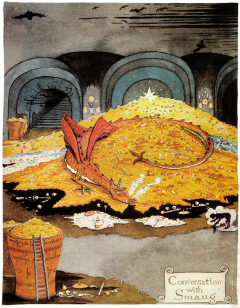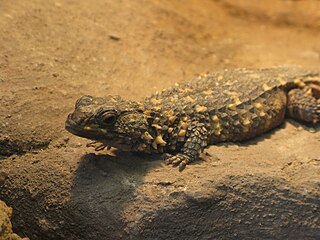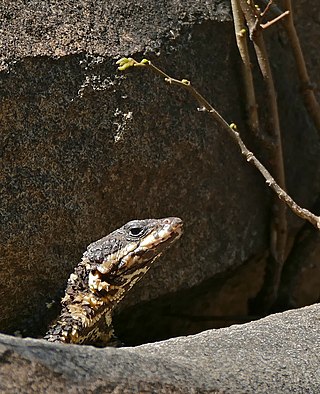Macroevolution usually means the evolution of large-scale structures and traits that go significantly beyond the intraspecific variation found in microevolution. In other words, macroevolution is the evolution of taxa above the species level.

Smaug is a dragon and the main antagonist in J. R. R. Tolkien's 1937 novel The Hobbit, his treasure and the mountain he lives in being the goal of the quest. Powerful and fearsome, he invaded the Dwarf kingdom of Erebor 171 years prior to the events described in the novel. A group of thirteen dwarves mounted a quest to take the kingdom back, aided by the wizard Gandalf and the hobbit Bilbo Baggins. In The Hobbit, Thorin describes Smaug as "a most specially greedy, strong and wicked worm".

Squamata is the largest order of reptiles, comprising lizards, snakes, and amphisbaenians, which are collectively known as squamates or scaled reptiles. With over 11,500 species, it is also the second-largest order of extant (living) vertebrates, after the perciform fish. Members of the order are distinguished by their skins, which bear horny scales or shields, and must periodically engage in molting. They also possess movable quadrate bones, making possible movement of the upper jaw relative to the neurocranium. This is particularly visible in snakes, which are able to open their mouths very wide to accommodate comparatively large prey. Squamates are the most variably sized living reptiles, ranging from the 16 mm (0.63 in) dwarf gecko to the 6.5 m (21 ft) Reticulated python. The now-extinct mosasaurs reached lengths over 14 m (46 ft).

The genus Cordylus includes a wide variety of species of small to medium spiny lizards from Africa, collectively called girdle-tailed lizards or girdled lizards. All are diurnal and ovoviviparous. Most species are rupicolous (rock-dwelling), while a few species are arboreal or live in burrows. They defend themselves with osteoderms and by quickly retreating into rock crevices or burrows. Many species live in groups, and males defend territories.
Arda or ARDA may refer to:
A dragon is a legendary creature, typically with reptile-like traits.
J. R. R. Tolkien's Middle-earth legendarium features dragons based on those of European legend, but going beyond them in having personalities of their own, such as the wily Smaug, who has features of both Fafnir and the Beowulf dragon.

The sungazer, also known as the giant girdled lizard, giant dragon lizard, ouvolk, or giant zonure, is the largest species of the Cordylidae, a family of lizards from sub-Saharan Africa. This threatened species is endemic to Highveld grasslands in the interior of South Africa. In 2011, it was assigned to the new genus Smaug, along with seven other species previously belonging to the genus Cordylus, based on a comprehensive molecular phylogeny of the Cordylidae.

The Mozambique girdled lizard or flame-bellied armadillo lizard is a large, flattened, girdled lizard found on Mount Gorongosa in Mozambique and low elevations in the Chimanimani Mountains at the border of Zimbabwe and Mozambique. It lives in rock outcrops in grasslands and dry, wooded mountain slopes.

Warren's girdled lizard is a species of relatively large, flattened lizard in the family Cordylidae. The species is native to Southern Africa.

The Lacertoidea is a group of squamate reptiles that includes the Lacertidae, Teiidae, Gymnophthalmidae, and Amphisbaenia. The finding from molecular phylogenetic studies that the burrowing Amphisbaenia were nested in a clade with the lizard forms led Vidal & Hedges (2005) to propose a new name for the group based on shared morphogical characters, Laterata, "referring to the presence of tile-like scales that form the rings in Amphisbaenia, and are also present ventrally in Lacertiformata and Teiformata".
Vivian Frederick Maynard FitzSimons, born in Pietermaritzburg, was a notable herpetologist in South Africa. Also, he contributed to the collection of spermatophyte samples for the National Herbarium which has become part of the South African National Biodiversity Institute at the Pretoria National Botanical Garden. In 1937, together with Anna Amelia Obermeyer, he collected some of the earliest plant specimens from the Eastern Highlands of Rhodesia.

Smaug is a genus of lizards in the family Cordylidae. The genus Smaug is a group of species of spiny southern African lizards, separated from the genus Cordylus in 2011 on the basis of a comprehensive molecular phylogeny of the Cordylidae. The type species is the giant girdled lizard, S. giganteus.

Van Dam's girdled lizard is a species of lizard in the family Cordylidae. The species is endemic to South Africa.

Zoutpansberg girdled lizard is a species of the genus Smaug. This species is only found on and around the Soutpansberg in South Africa and was before considered a subspecies of Warren's girdled lizard. Zoutpansberg girdled lizard's grow to a length up to 16 centimeters.

Smaug is a RNA-binding protein in Drosophila that helps in maternal to zygotic transition (MZT). The protein is named after the fictional character Smaug, the dragon in J.R.R. Tolkien's 1937 novel The Hobbit. The MZT ends with the midblastula transition (MBT), which is defined as the first developmental event in Drosophila that depends on zygotic mRNA. In Drosophila, the initial developmental events are controlled by maternal mRNAs like Hsp83, nanos, string, Pgc, and cyclin B mRNA. Degradation of these mRNAs, which is expected to terminate maternal control and enable zygotic control of embryogenesis, happens at interphase of nuclear division cycle 14. During this transition smaug protein targets the maternal mRNA for destruction using miRs. Thus activating the zygotic genes. Smaug is expected to play a role in expression of three miRNAs – miR-3, miR-6, miR-309 and miR-286 during MZT in Drosophila. Among them smaug dependent expression of miR-309 is needed for destabilization of 410 maternal mRNAs. In smaug mutants almost 85% of maternal mRNA is found to be stable. Smaug also binds to 3′ untranslated region (UTR) elements known as SMG response elements (SREs) on nanos mRNA and represses its expression by recruiting a protein called Cup(an eIF4E-binding protein that blocks the binding of eIF4G to eIF4E). There after it recruits deadenylation complex CCR4-Not on to the nanos mRNA which leads to deadenylation and subsequent decay of the mRNA. It is also found to be involved in degradation and repression of maternal Hsp83 mRNA by recruiting CCR4/POP2/NOT deadenylase to the mRNA. The human Smaug protein homologs are SAMD4A and SAMD4B.

Smaug breyeri, also known commonly as the Waterberg dragon lizard or the Waterberg girdled lizard, is a species of lizard in the family Cordylidae. The species is endemic to South Africa.

Smaug barbertonensis is a species of lizard in the family Cordylidae. It is a small lizard found in eastern South Africa and Eswatini.
Smaug regius is a species of lizard in the family Cordylidae. It is a small lizard found in Zimbabwe.
Smaug swazicus is a species of lizard in the family Cordylidae. It is a small lizard found in South Africa.











